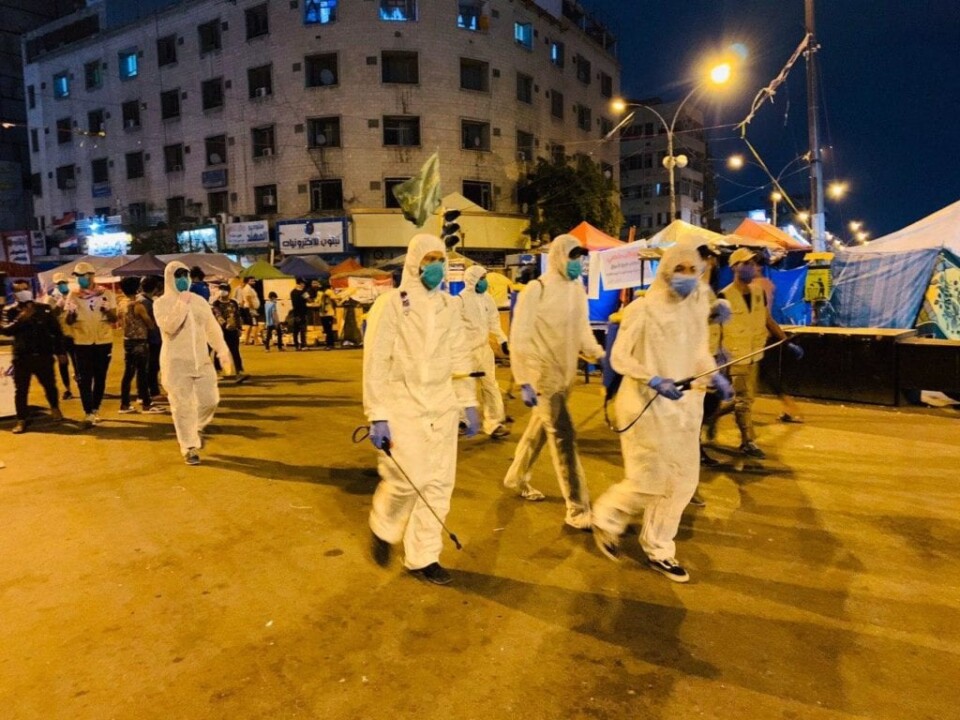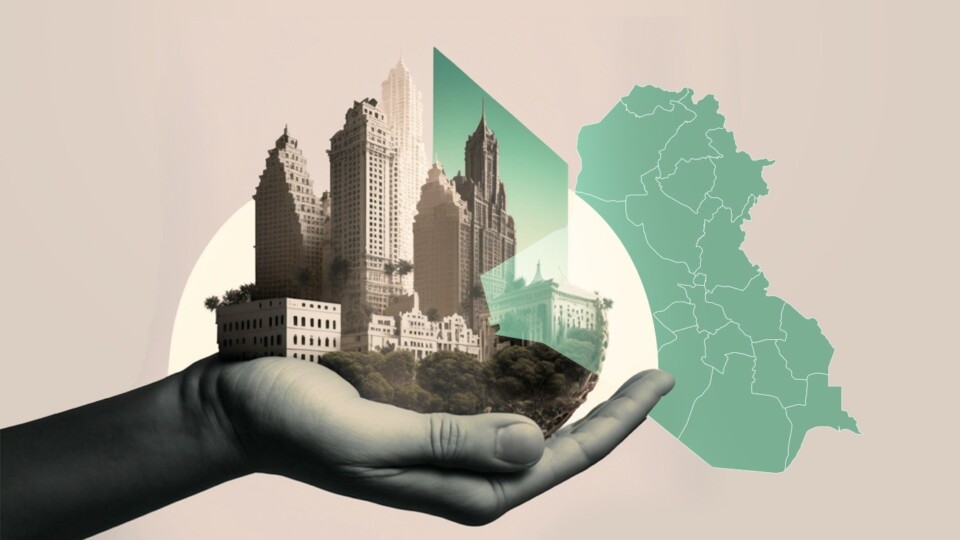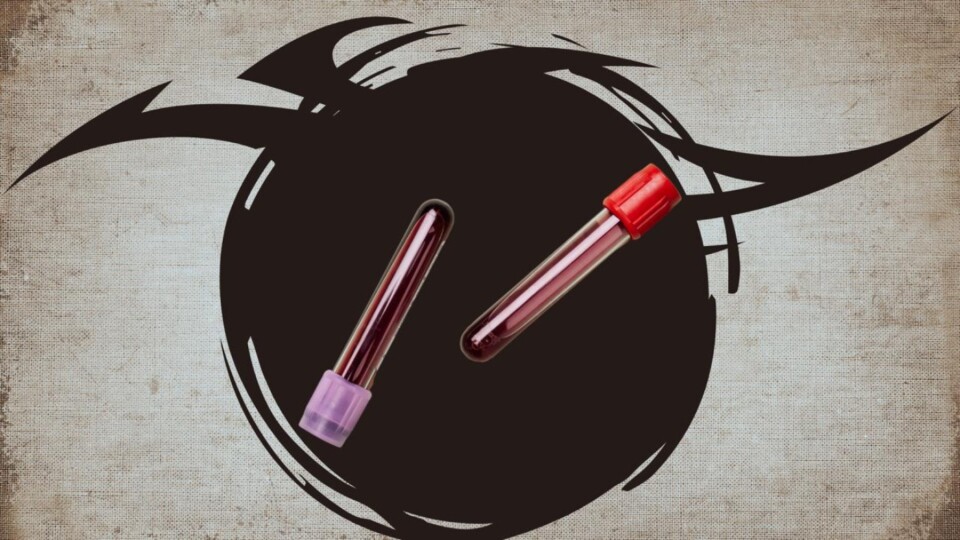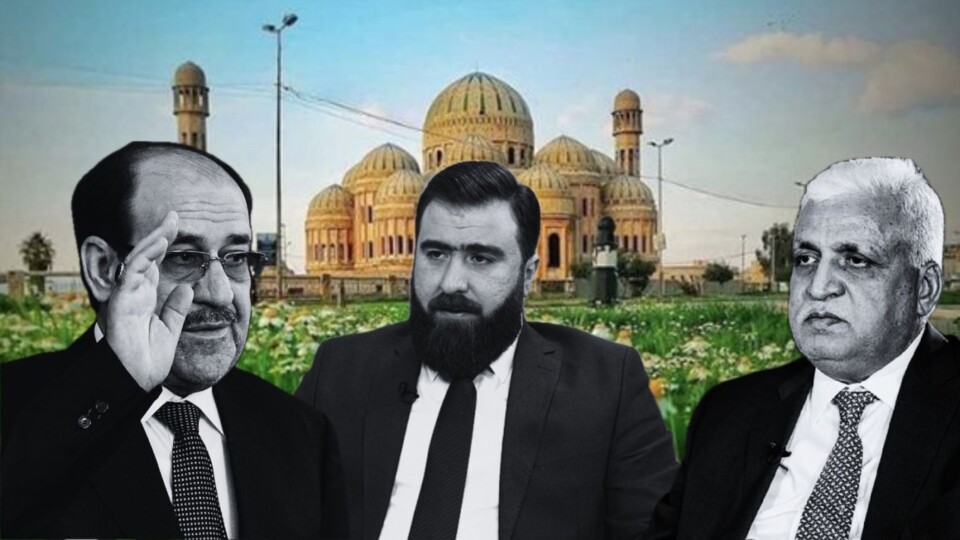

Ali Al-Zaidan – Iraqi journalist
April 2020April 2020
“We are waiting for the curfew and lockdown to end, and for the nature of the new government to become clear, to launch another wave of demonstrations. We have no other choice …”
Muhammad al-Yasiri (24 years old) sits on a concrete block at the entrance to his small tent in Tahrir Square in central Baghdad, holding his mobile phone, trying to overcome the sleepiness in the midst of the calm that prevails in the square that has turned into a stronghold for the protesters demanding a change of the ruling political class in Iraq.
He briefly closes his eyes, then opens them heavily, resting his head on his knees. It is his role in the night watch in the ” Daklawi Sons” camp, which consists of about 20 tents that were set up in the Ummah Park on the edge of the square, which for 6 months witnessed waves of mass demonstrations that were met with violence by the security forces and armed groups that left hundreds dead and thousands injured.
Al-Yasiri looked exhausted. He got up and looked at the tents before entering his tent and lying on his bed, leaving his shift on guard.
“Calm has prevailed in the place for weeks, but caution is required, as they may do anything to end the sit-ins,” said Al-Yasiri, who has been in Tahrir since the beginning of the popular movement in early October 2019, in which millions of Iraqis participated and pushed the government of Adel Abdul Mahdi to resign.
He adds, pointing to a bag of bread placed on a small table: “For six months they have failed to end the protests, and today they want to take advantage of the curfew and the emergence of the Corona virus to end it … For about two months, they blocked the roads around us and obstructed the arrival of food to us.”
He closes his eyes as he feels his stomach. “We had days before Ramadan, when we only ate one meal, but we did not give up … We will stay here until we change the ruling political regime and the mechanism of running the country.”
Curfew, Hunger and Challenge
With the government announcing a curfew in most areas of the country, preventing all kinds of gatherings, and imposing measures to block roads to confront Corona, thousands of protesters refused to leave the protest squares that are spreading in Baghdad and the Shiite-majority cities of central and southern Iraq.
In Tahrir Square, which is the focal point for demonstrations in Baghdad, thousands of protesters refused to remove their tents and stop their protests. Despite the risk of the spread of the virus and the measures of restrictions and complete closure, they decided to continue their sit-in to prevent any plans to stop this rare move, which shocked the government and pushed it to announce a series of reforms and changes .
Since that time, calm prevails in the square, in which hundreds of tents are still standing on its various sides, while the protesters imposed preventive measures to counter Corona virus, such as physical distancing and reducing mixing between the demonstrators.
Anticipation and Readiness
Anticipation is the dominant factor in all the protest squares, and there is nothing new in the scene with the advent of the month of Ramadan and the easing of the curfew measures by lifting it during the day and keeping it at night : Protesters who have been away from their families for months, facing the curfew measures and the risk of being targeted and kidnapped by “chasers” within the security barricades surrounding them, and the lack of supplies, even though the flow of some foods to the square, contributed to alleviating it.
Protester (JA) says, while following up the news on his laptop of the formation of the new government: “We are waiting for curfew and lockdown to end, and for the shape of the new government to become clear, so as to launch another wave of major demonstrations … We have no other choice to change the way our country is run, and expel this corrupt this political class. ”
Pending the end of the curfew or developments that require an urgent movement from the protesters, and with the arrival of new demonstrators to Tahrir Square and the flow of some foods supplies, activists believe that the most difficult stage to ensure the continuation of the protests is about to end.
In a small group with a number of his companions, Ahmed (26 years old) discusses arrangements for staying in their tent, dividing their duties, and determining who will stay and who will go home. He says: “We divided ourselves into two groups, the first goes home to reduce numbers and mixing, and the second remains in Tahrir square to preserve the revolution.”
Ahmed is afraid of anti-protest attacks, just as he fears infection with the Corona virus, so every two days he and those with him sanitize their tent and neighboring tents and are keen on guarding and controlling their movement back and forth, “We have taken the necessary measures, and no matter how dangerous the situation is, we cannot back down.”
Support Decline
Just before dawn, “Ali Razzaq” (24 years old) was busy in front of his tent at the edge of the Ummah Garden frying potatoes and eggs, while looking from time to time to his comrades waiting for their Sahour.
He says, “I don’t know how three loafs of bread, some potatoes and eggs, will be enough for the seven of us.” “Not much has changed. Before Ramadan, we also had to eat two meals a day,” he says.
Razzaq attributed the reason for the decline in material and logistical support, in light of the curfew, to “blocking roads and the difficulty of car access to Tahrir, as well as fear of prosecution for supporting protesters.”
Protesters believe that the extension of the protests for more than six months and the fluctuations in the positions of some of the parties participating in the demonstrations affected the logistical support in general, even before the curfew, which forced the protesters to rely on themselves and bring the supplies available from their homes.
However, with the beginning of the month of Ramadan, food supplies provided by donors poured into the protesters. The square witnessed the organization of many group Iftar meals during the past days.
Before Ramadan and under the comprehensive curfew, the protesters in the Sons of Daklaoui camp were forced to walk about 10 minutes to Al-Saadoun Street to get bottles of water from one of the tents.
“A few days ago, we shared one small bottle of water,” says Ali Al-Zainabi, referring to two of his friends sitting in the tent. He continued with a smile on his face: “We do not have money. For half a year we have been here in Tahrir… Some have not seen their family for months.”
With the advent of the month of Ramadan, many tents began to share the Iftar meal, and most of the protesters were content with anything available for the Sahour meal.
Sajjad (22 years old), who came from Karbala to Tahrir square, says that the situation is now better. Before Ramadan, 11 large tents shared a lunch that was delayed until about 4 p.m. before it was ready: “We used to gather what was available between us and take it to the tent responsible for cooking”.
He adds: “Tahrir today, with the Corona crisis and the lack of logistical funding, has become divided on the basis of regions, each group shares a store and one kitchen for food. In Al-Saadoun , tents share one store and a kitchen, and so did the tents of Tahrir Square and Al-Jumhouri, and Al-Khilani tents as well.”
Poor People seek Help from the Protesters
Protesters share their already limited meals with the poor from the nearby areas, including workers who were dependent on what they earn from their daily work.
Protester Muhammad Hussein said, “Despite our limited resources, many needy people come to share our food or to ask for supplies.”
This was confirmed by protester Sajjad, pointing to a gray-headed man wearing a worn-out shirt, who was slowly approaching the tents of Tahrir Square and staring at it with glimpses before stopping in a tent where food is being cooked. He comes every other day asking for rice and oil to feed his family. He says he is a cart worker and his income has been cut off since the curfew was imposed.
Ali notes that the food was a lot and the supplies did not stop in the first two months of the protests, before they diminished in February, “and with the emergence of Corona in March, we started eating no more than two simple meals.”
But protester A.S, believes that the main reason for the decline in support is due to “the kidnappings and intimidation that were practiced by the parties, which prompted many supporters to withdraw in fear for themselves.” This made the tents dependent on their stocks and the supplies that the protesters and their families bring,before the curfew started, which worsened the situation.
A.S. who was in one of the logistical support tents before the emergence of “Corona”, was kidnapped for four days by an unknown party. The kidnappers threatened him with a heavy punishment if he returned to the protest, but he decided to return during the period of a comprehensive curfew. He says, “My family prepared food baskets. There was no way to deliver them to Tahrir other than communicating with the Baghdad Municipality and informing them about the baskets for poor families.”
He adds, “I was afraid to tell the driver that the baskets were for the Tahrir protesters, so he wouldn’t change his mind … in the end I told him the truth and he agreed to help me.”
A.S confirms that his kidnappers accused him of being associated with and receiving support from foreign embassies: “They had ready comments in response to my rejection of those charges … and with every answer that did not satisfy them, I was beaten.”
Ready Blocking Lines
Near the blocking line in Al-Khilani Square, the twenty-year-old, Hussein, stands with a “slingshot” in one of his hands, gazing at the top of the concrete castings where the anti-riot agents are located. A few meters away, several of his colleagues were sitting leaning against the wall of an old building. Most of them are young men in their twenties who decided to continue to sit in and not return to their families.
Hussein, who filled his pocket with small stones, says that the “slingshot” that he carries is his only means “to repel any attack or the advance of anti-riot forces who use teargas, shotguns, or even live bullets.”
He added, “We are here to monitor their movement … Since the start of the Corona crisis, there have been only two clashes.”
Demonstrator Ali Al-Saadi, who appeared in his thirties, crosses the protest lines, to rise to the top of one of the concrete blocks of the riot police, and exchange talks with them, before returning to the demonstrators’ site, and says: “The truce continues. We have not received instructions to escalate.”
Activists in the protests attributed the reason for the cessation of the skirmishes and clashes between the two sides, which left 553 dead and more than 24,000 wounded until mid-March, according to the High Commissioner for Human Rights, to the small number of demonstrators and the lack of enthusiasts who break the truce, waiting for the course of events to become clearer with the end of Corona problem and the formation of the new government, and to the protesters’ realization of the importance of staying in tents and avoiding gatherings to prevent infections with the “Corona” virus.
Al-Saadi says: “We always made truces, but they quickly broke under the pressure of events and developments, but Corona imposed a long truce on everyone. We do not know when it will end.”
Ahmed Khaldoun, who is in charge of the “First Responder” team that contributes to relief operations in Tahrir Square and the surrounding protest areas, comments that “any rumor spreading about the intention of the riot forces to advance pushes the protesters out of their tents and gathering to confront them … This happens from time to time.”
He added, “These rumors are often released by the security forces among the demonstrators, so they leave their tents and assemble. This matter is a source of health danger and allows the security forces to know the approximate numbers of the protesters at the place.”
The calm that prevailed in Tahrir Square and the rest of the sit-in squares in the country during March and April was interrupted by rounds of clashes and bloody events.
Mustafa Kazem, who is a demonstrator in al-Haboubi Square in the center of Nasiriyah, says that clashes and escalation attempts took place in the past period, the purpose of which was to end the ongoing protests and sit-ins and take advantage of the curfew, under the excuse of preventing the spread of the virus.
Corona and Change of Plans
The emergence of the “Corona” virus forced the demonstrators to stop their protests and reduce gatherings, in addition to participating in efforts to continuously sterilize the squares and their surroundings. The protesters launched the hashtag (#Stay_In_Your_Tent) on social media.
“In the first weeks, we did not go out of the tents except in case of emergency,” says protestor, Ali Razzaq.
In Nasiriyah, protester Muhammad Kadhim, confirms that the number of people in each tent will be reduced, and journalist Haider al-Janabi says that the safety requirements have prompted a reduction in the number of sit-ins in the Najaf sit-in square, indicating that the square and tents are subject to permanent disinfection.
In Baghdad, after the emergence of “Corona”, and to protect new protestors, three booths were set up to sanitize those heading to the square. “We installed the booths in the early days of the curfew,” Sajjad says. “We were afraid that an infected person, who was pushed by political parties, would enter and cause Corona cases here.”
At the door of some tents in Tahrir hangs a container of alcohol tied to a rope, which everyone who enters must use to sterilize their hands. Ghassan Sabri (26 years old) says, “We have taken preventive measures, and all who enter our tent must sterilize their hands and the materials they carry.”
Many of the camps distributed in the square invite their visitors, even if they are from neighboring tents, to sterilize their hands and their shoes, and they are keen to sit at the edge of the tent, far from their group, according to Muhammad al-Yasiri.
Volunteers, such as the “first responder” team and the Baghdad Students’ Union, are disinfecting the tents using small sprinklers placed on the back.
The activity of the “first responder” team, which was established by activists with the outbreak of the protests in October 2019, was limited to quick response to those in need of first aid and then sponsored a number of medical teams in the square, to turn today into a first line of defense against “Corona” in the square.
The team provides sterilization and protection materials, in addition to conducting temperature tests. “The ambulance takes time to get to Tahrir, so we bought a remote thermometer to deal with suspicious cases,” said Ahmed Khaldoun, the team leader.
The work of the team was not limited to Tahrir Square but went beyond it to the neighboring neighborhoods for fear of virus infections that might threaten those in the square. Khaldoun says, “There are residents in nearby areas who come to Tahrir to ask for food, so we included them in the disinfection plan.”
Quiet under the Freedom Monument
“For the first time, I witness the absence of demonstrators from the space under the Freedom Monument, where various activities were being organized. In the tents, it was evident that the number of protesters decreased to a large extent, ” said Ziad Abdullah, who visited Tahrir Square after nearly two months of absence.
Mustafa (25 years), who is from Nasiriyah, estimates the numbers in Tahrir Square to be less than a thousand people distributed in about 350 tents. He says: “With the emergence of the virus, we agreed to reduce the number of those present here by sending some to their homes,” indicating that most of those who remained in the square were who arrived from outside Baghdad.
Those who remained in the sit-in square follow the strictest guidelines to prevent the spread of the virus, from stopping gatherings, staying inside tents for hours, not mixing with strangers, continuous sterilization, and even sunbathing of mattresses and blankets.
“We got used to this for weeks,” Mustafa says while carrying his mattress outside his tent to spread it in the sun. “In the early days, the narrow corridor at the outskirts of the nation’s garden was filled with mattresses.”
A.S says, “Everyone in Tahrir square today is committed to preventive measures and physical distancing, so they are committed to procedures more than some areas in Baghdad, such as Sadr City.”
The temporary halt to the protests did not prevent the protesters from expressing their stands on the developments, but they changed the way of expression and resorted more to social media networks, which is what Ali Al-Zainabi did, who published a picture of the former prime minister, Adnan Al-Zorfi, with an “X” sign, meaning he is refused.
Protesters also posted pictures of them in front of their tents carrying banners rejecting the party’s nominations for the new government headed by Mustafa Al-Kazemi, and on several sites they uploaded pictures of candidates for ministries with an “X” sign.
On April 13, the youths of the sit-in protesters in Tahrir Square organized a silent march that kept physical distancing, to announce their rejection of Al-Kazemi, as dozens of people wearing masks and carrying banners gathered ,with one meter distancing. “The march had two goals, the first was to show that the square rejected Al-Kazemi, and the second was an awareness-raising message to adhere to the prevention measures,” said Ikram, 21.
Million People March after the Curfew ends
With the curfew being eased, protesters in Tahrir Square launched a campaign to distribute publications calling for “a return to the October Revolution,” and mentioned its goals, with the hashtag ” Million People March after the Curfew ends.”
Preparations were not limited to Baghdad, as in Wasit Governorate, in the south of the country, demonstrators announced unprecedented movements.
Demonstrators from Baghdad and other governorates supported these calls, promising a “new round” of protests and a “march towards the green zone” if their demands were not met.
The demonstrators demand the formation of a national government that confines weapons in the hands of the state and holds the killers of demonstrators accountable, and the adoption of a fair election law and the formation of an independent commission for it that paves the way for early elections.
“The mobilization and campaigns that we launch aim to remind of the demands of the revolution, especially after the absence of media coverage,” says Bassam Al-Saray, a member of the Baghdad Students’ Union and one of the supporters of the launch of a new round of demonstrations after the threat of “Corona” has passed.
Ikram, who in turn belongs to the Baghdad Students’ Union, believes that the current political system “and after its involvement in killing demonstrators and turning into repression and confiscating the right to protest and stalling implementing our demands, it no longer has legitimacy, so we want to overthrow it.”
He adds: “There will be an escalation after the Corona crisis … We are preparing for a new million people march, and we are thinking of surrounding the Green Zone doors.”
While these calls are greeted with enthusiasm from some of the protesters who are “tired of waiting,” many of the leaders of the movement coordination group believe that the new government should be given an opportunity to prove its seriousness in “changing the political course and moving to hold the perpetrators of the killings of demonstrators accountable.”
We Won’t Wait Long
One well-known activist in the protests says, “We have to endure maybe two months more to see what the new government will do. We will not leave the sit-in squares, but we will prepare for escalation. In July and August there will be heated confrontation rounds.”
He adds: “We remind the government of the many pressing files that cannot be escaped from through promises and political settlements, including unemployment and poverty that have increased with Corona, and the threat to employees’ salaries with the decline in oil prices.”
This activist excludes, that the participation of the Sadrists in the new government will have an impact on ending the demonstrations “For months they have wanted to overpower the demonstrations to their side. Their positions are volatile and they overlook the rest of the demonstrators from time to time. Many protestors no longer rely on them to lead the protests that will continue without them even if they decide to support the other side”.
“We will not wait for long,” said the protester (K.J), as he was fortifying one of the buffer lines facing the security forces near the Jumhuriya Bridge. He adds, pointing with his hand beyond the river: “If our demands are not fulfilled, we will go up again and start million people marches, perhaps in a final decisive round, to achieve change.”
* The report was compiled with the support of the NIRIJ Investigative Journalism Network
Reports
Reports","field":"name"}],"number":"1","meta_query":[[]],"paged":1,"original_offset":0,"object_ids":21724}" data-page="1" data-max-pages="1">











